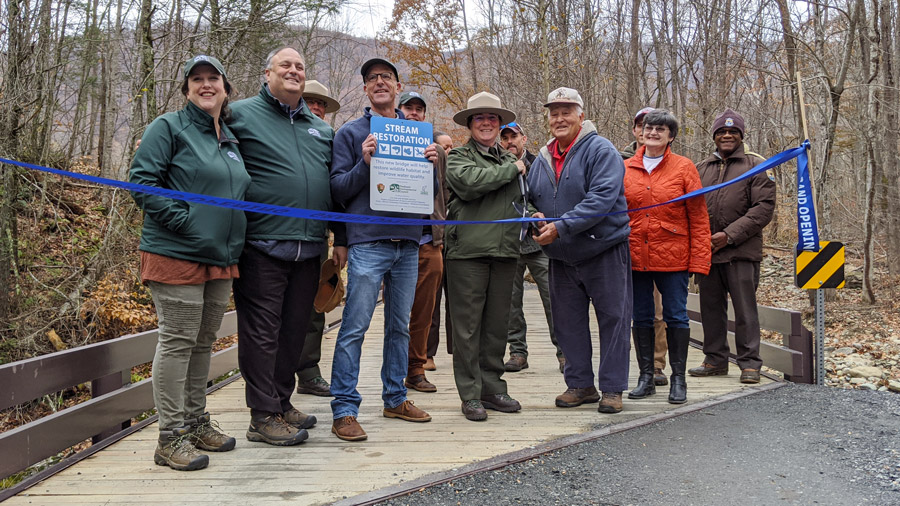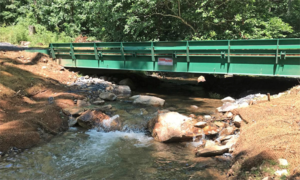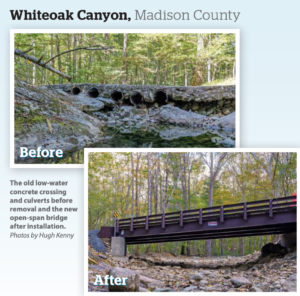
As the fog broke on a brisk November morning in Madison County, more than three dozen people arrived at the Whiteoak Canyon trailhead ready to celebrate the new, 35-foot, open-span bridge over Cedar Run. They marveled at the sounds of water bubbling over the rocky streambed from the north side of the bridge to the south. Many walked upright beneath the sturdy, brown, steel-framed structure. And all excitedly searched the deep pools for our guests of honor—the native brook trout, a species of concern on Virginia’s Wildlife Action Plan. As landowner Jimmy Graves and Shenandoah National Park Superintendent Jennifer Flynn ceremoniously cut the royal blue ribbon, all cheered this new installation in a long-term PEC initiative to help bring native brook trout back to these historic spawning grounds.
Clothed in shimmering blue and dark olive with spots the color of many sunsets, the beloved brook trout are surrounded in mystique for their beauty, brains, and brawn. Their existence has been intertwined with the culture and livelihood of the people of the Appalachian Mountains and Shenandoah Valley for generations. And, since brook trout survive only in clean, cold water, their presence, or absence, speaks volumes about what’s happening in the environment around them. Sadly, once abundant in Virginia and all along the eastern seaboard, within the Virginia Piedmont they’ve almost vanished from all but the remote headwater streams in and around Shenandoah National Park.
Pollution, changing climate conditions and land use alterations have all played their role, but a major factor in the struggle for the brook trout is the man-made stream crossing. Designed for the passage of humans, rather than fish, “these undersized culverts pinch streams and break up hundreds of miles of trout streams into thousands of short, disconnected segments that prevent trout from reaching the spawning grounds so important to a thriving population,” said PEC Habitat and Stewardship Specialist Celia Vuocolo.
PEC has been hard at work connecting local landowners, conservation partners, and funding to bring native brook trout back to the Piedmont since 2013. A PEC survey of 133 public and private road-stream crossings in Albemarle, Greene, Madison, and Rappahannock counties found that roughly half were acting as barriers to fish movement. “Our goal is pretty simple: by removing these barriers and replacing them with fish-friendly designs, we can reconnect miles of stream and help brook trout not only thrive, but also give them the chance to move back into streams where they once historically lived,” Celia said.
A fish-friendly crossing could be an open-span bridge, like the one at Whiteoak Canyon, a roadway built upon a series of large, bottomless arch culverts, or properly-sized and “countersunk” culverts. These road-stream crossing options preserve natural streambed features and hydrology, which helps prevent localized flooding and erosion. Nearby neighbors benefit from reduced property damage and lower maintenance costs. Miles downstream, less sediment makes its way into the Chesapeake Bay.
PEC has completed a series of trout stream restoration projects, beginning with two private driveway culvert replacements on the Robinson River in Madison County and Sprucepine Branch in Rappahannock County, both in 2017. These two projects have added more than seven miles of aquatic habitat and restored over 400 linear feet of streambank. In 2019, with the completion of its largest stream restoration project yet, PEC added another 1.4 miles of newly-restored aquatic habitat at Bolton Branch, near Huntly.

Working with Ecosystem Services and U.S. Fish and Wildlife Service for project engineering, and Shenandoah Streamworks, a stream restoration construction company, we removed a private driveway culvert on Bolton Branch, replacing the low-water ford with a 40-foot bridge that spans the natural channel completely and gives fish full access to travel upstream into the nearby Shenandoah National Park. Additionally, nearly two acres of riparian buffer are replanted with 300 native trees and shrubs; and nearly 800 feet of linear streambank are restored to significantly reduce pollutants like phosphorus, nitrogen and sediment.
“The Bolton Branch project was always about the brookies,” says Claire Catlett, PEC’s Rappahannock field representative who oversaw this stream restoration project. “Everyone involved in this project—three landowners and their families, multiple contractors, and a whole community of funders—made the brook trout a priority, and we are most humbled by this little fish and its ability to connect people back to their land.”
The next big leap for the brook trout is the expansion of our efforts beyond private crossings to include public crossings, largely owned by the Virginia Department of Transportation (VDOT). Two VDOT road-stream crossings at Piney River and Bolton Branch in Rappahannock County are slated for replacement in 2020-2021, and PEC has successfully put together nearly $350,000 in grant funding and technical support from USFWS and the National Fish and Wildlife Foundation.
“Ultimately, our long-term goal is to equip and empower VDOT with the tools and knowledge they need to seek out stream restoration projects for themselves, while we continue to bring funding and partners together to help landowners with private crossings,” Claire said.
Back at Whiteoak Canyon, the reality of that long-term goal has set in. Our work with Trout Unlimited to replace the failing low-water culverts with the new bridge over Cedar Run goes a long way to restore not just fish passage, but the public’s access to the popular trailhead just a few hundred feet upstream.

“This bridge is an incredible gift to the American people. Visitors coming to Shenandoah National Park now have safe passage to their trailhead, and they will reap the benefits of improved fish habitat within the park,” said Jennifer Flynn, park superintendent. “The Piedmont Environmental Council and Trout Unlimited have done all the legwork to make sure this happens. They not only identified the problem and brought us a solution, they fundraised for it, they worked with the contractor to execute the work properly, and made sure that we were environmentally sensitive while we were doing it.”
Standing on the bridge over Cedar Run that November morning, USFWS project leader Albert Spells said, “This is a prime example of how partnerships work. We couldn’t do this alone, and we have been so blessed to have good partners to work with to bring these kinds of projects to fruition. This is a win-win situation for all of us.”
PEC is grateful to the partners and funders who have supported the trout restoration initiative to date: U.S. Fish and Wildlife Service, Shenandoah Streamworks, Virginia Department of Game and Inland Fisheries, Trout Unlimited, Friends of the Rappahannock, VDOT, Shenandoah National Park, Ecosystems Services LLC, the Ohrstrom Foundation, Nimick Forbesway Foundation, and PEC’s Krebser Fund for Rappahannock County Conservation.
This article was featured in our Winter 2019 member newsletter, The Piedmont View.
